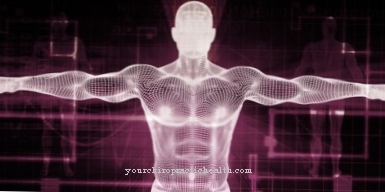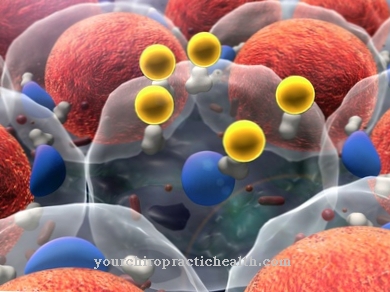Of the Oppenheim reflex or that too Oppenheim sign is a natural reflex in babies and a pathological reflex in adults. Neurology associates this reflex movement with the signs of the pyramidal trajectories, as they occur when central motor neurons are damaged. Diseases such as multiple sclerosis (MS) or ALS can cause such damage.
What is the Oppenheim reflex?

The neurologist understands the Oppenheim reflex to be a pathological reflex that can be symptomatic in the context of central nervous system diseases. The symptom is also known as the Oppenheim sign. The reflex movement is a foot reflex that can be triggered by wiping the front edge of the shin.
The Oppenheim reflex is one of the so-called pyramidal trajectories and indicates damage to the pyramidal tract or the central motor neurons, which are responsible for controlling muscle movements. The pyramidal tracts are central nervous systemic motor tracts in the spinal cord through which the voluntary movements of the entire body are controlled.
The pathological reflex was named after its first person to describe it, Hermann Oppenheim. The German neurologist discovered the reflex movement, which is only pathological at an advanced age, as early as the 19th century.
Function & task
The pyramidal tracts in the human spinal cord are the control center of voluntary motor skills. They are connected to the motor alpha neurons in the skeletal muscle fibers and are part of the descending or efferent pathways of the nervous system. Information is transmitted from the central nervous system via efferent pathways. In the case of the pyramidal trajectories, the goal of this transmission is the skeletal muscles.This is how the muscles receive their movement commands.
The central point in the spinal cord controls the reflexes in particular. A large part of these reflexes form the protective reflexes, which are primarily intended to prevent injuries. Such reflexes are triggered by what is known as a trigger. Usually this trigger is a specific perception. If the switching point for the reflex movements were not in the spinal cord but in the motor cortex of the brain, then the movement information would not arrive in the muscles quickly enough. The reflexes could no longer protect people in this way. In particular, protective reflexes must therefore be connected over the shortest possible paths in order to fulfill their purpose.
For example, if a ball or other object flies towards the human face, the corresponding reflex movement is a defense of the object by the arms. If the control of this movement were via the brain, then the person concerned would only raise his arms when the object has long since reached him and the protective reflex would no longer be of any use.
The reflex control via the pyramidal trajectories has evolutionary practical causes. In contrast, the muscle movements of the organs, for example, are not controlled via the pyramidal trajectories. They are interconnected in the enteric and vegetative nervous system.
Some reflexes in the human body are limited to infancy. This includes, for example, the suction reflex. This reflex movement occurs as soon as an infant's lips are touched. The Oppenheim reflex is also physiological in infants. When the front edge of a baby's shin is firmly brushed with the fingers, the big toe moves upward tonic as part of the reflex. The remaining toes tend to spread apart.
If this reaction can be observed in an adult, then we are no longer talking about a physiological, but a pathological reflex. The Oppenheim reflex is therefore not present in healthy adults.
Illnesses & ailments
The Oppenheim reflex is a symptom. Often the reflex movement occurs together with other pathological reflexes. The Babinski reflex, the Gordon reflex and the Chaddock reflex as well as the Strümpell signs, like the Oppenheim sign, belong to the so-called Babinski group, which is associated with the concept of the pyramid orbit signs. This group of symptoms is an indication of damage to the central motor neurons to the neurologist. The reflex examination is a standard procedure in neurology. Lots
Neurological diseases can be associated with pathological reflexes from the Babinski group and thus damage to central motor neurons. One of the best known diseases in this context is multiple sclerosis. In this autoimmune central nervous system disease, the patient's own immune system falsely attacks the body's own nervous tissue in the central nervous system and causes an immunological inflammatory reaction.
As part of the inflammation, the isolating myelin sheath breaks down in the central nervous tissue. This reduces or loses the conductivity of the nerve tissue. In the worst case, this causes permanent damage to the brain and spinal cord.
In connection with multiple sclerosis, the pyramidal orbit signs and thus also the Oppenheim reflex are particularly relevant for the prognosis. If signs of the pyramidal tract are present at an early stage of the disease, the doctor speaks of a rather unfavorable course.
Other diseases can also damage the central motor neurons and thus trigger signs of the pyramidal trajectory. One example of this is the degenerative disease ALS. In this disease of the motor nervous system, the nerve cells that are responsible for muscle movements are broken down piece by piece. Both the motor neurons in the brain and those in the anterior horn of the spinal cord are affected by the degenerative symptoms. The degeneration cannot be stopped. At best, the dismantling can be delayed. If the first motor neuron is affected, muscle weakness progressing to the point of paralysis occurs. If, on the other hand, the second motor neuron is affected, this usually results in spasticity.



























